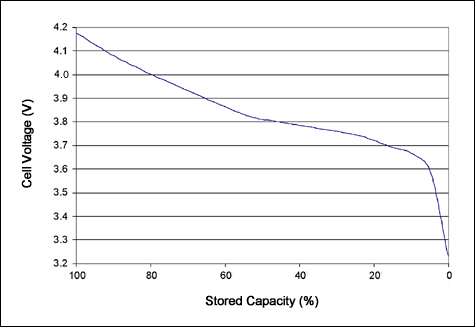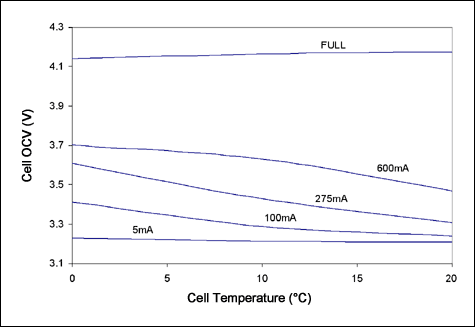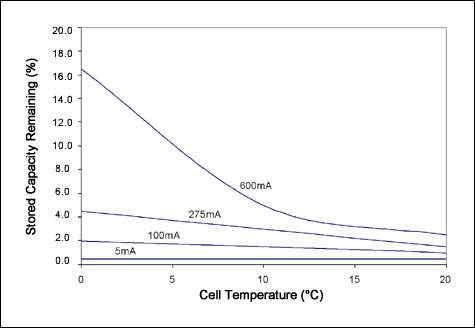Interpreting the Open-Circuit-Voltage (OCV) Fuel Gauge of the DS2786
Abstract
The DS2786 is an open-circuit-voltage (OCV) based fuel gauge that reports the total energy that is stored in a Li+ cell. The OCV is a good indicator of the stored energy in a Li+ cell over normal operating temperatures. However, because the impedance of the cell varies with temperature, the amount of energy that can actually be delivered to the application will differ from the energy that is stored in the cell. This application note describes how to enhance the DS2786's OCV-based fuel gauge to accurately estimate the amount of energy that can be delivered to an application over various temperatures and loads.
Introduction
The DS2786 stand-alone OCV-based fuel gauge estimates the available capacity of rechargeable Li+ batteries based on the cell voltage in an open-circuit state following a relaxation period. The open-circuit voltage is used to determine relative cell capacity based on a lookup table stored in the IC. This capability makes accurate capacity information available immediately after a battery pack is inserted.
However, because the cell's impedance varies with temperature, deliverable capacity may differ from the remaining capacity reported by the DS2786, depending upon the temperature and load. This application note describes how to interpret the DS2786's OCV-based fuel gauge readings and accurately estimate the amount of energy that can be delivered to an application at a specific temperature and load.
Characterizing a Cell
To illustrate how to enhance the OCV-based fuel gauge, this application note provides an example that uses the OCV profile for an 1100mAh cell that has been characterized by Dallas Semiconductor. The cell was charged at 20°C under a constant current of 950mA until the cell reached 4.2V. The cell was then charged at a constant voltage of 4.2V. When the charge current tapered off to 50mA, the cell was considered Full (100%). The cell was then discharged under a 220mA load (0.2C) until the cell voltage reached 2.5V. At this point, the cell was considered Empty (0%).
The profile was then summarized into an 8-segment linear approximation that can be stored in the DS2786. Table 1 shows the Capacity and Open-Circuit-Voltage pairs for this particular cell, and Figure 1 charts its OCV profile.
| Capacity (%) | OCV (V) | |
| Breakpoint 8 | ||
| Breakpoint 7 | ||
| Breakpoint 6 | ||
| Breakpoint 5 | ||
| Breakpoint 4 | ||
| Breakpoint 3 | ||
| Breakpoint 2 | ||
| Breakpoint 1 | ||
| Breakpoint 0 |

Figure 1. This illustration charts the OCV profile for the data in Table 1.
The cell was further characterized over temperature (0°C, 10°C, and 20°C) to determine the OCV at various states of charge. For this application note, it is assumed that changes in the profile are neglible above 20°C.
The cell was charged to Full as described above. The cell was then discharged to 3.2V under the following loads: 600mA, 275mA, 100mA, and 5mA. These discharge rates represent the multimedia mode, communication mode, backlight mode, and standby mode, respectively, of a wireless handheld device.
Once each full and empty point was reached, the cell was allowed to rest for one hour and the OCV was recorded (Table 2). Figure 2 provides a graph of the cell's OCV profile relative to cell temperature.
| Open-Circuit Voltage (V) | |||
| Full | |||
| Empty 600mA | |||
| Empty 275mA | |||
| Empty 100mA | |||
| Empty 5mA | |||

Figure 2. Data from Table 2 charts the OCV profile of the example cell relative to cell temperature.
A DS2786 was loaded with the profile shown in Table 1 and attached to the cell during this experiment. The DS2786 estimated the Remaining Capacity at each full and empty point as shown in Table 3; Figure 3 charts the data from Table 3.
| Remaining Capacity (%) | |||
| 0°C | 10°C | 20°C | |
| Full | 96.5 | 99.0 | 100.0 |
| Empty 600mA | 16.5 | 5.0 | 2.5 |
| Empty 275mA | 4.5 | 3.0 | 1.5 |
| Empty 100mA | 2.0 | 1.5 | 1.0 |
| Empty 5mA | 0.5 | 0.5 | 0.5 |

Figure 3. This chart shows the remaining capacity reported by the DS2786 relative to cell temperature. Because the impedance of the cell varies with temperature, the cell is unable to deliver all of its stored capacity.
Derating the DS2786's Reported Capacity
Table 3 illustrates that not all of the energy stored in a Li+ cell can be delivered to the application under various temperatures and loads. In order to derate the capacity that is reported by the DS2786, simply subtract the energy that cannot be delivered at the present temperature and load.
For example, assume that the current consumed by the application in communication mode is 275mA. According to Table 3, at 20°C 1.5% of the energy that is stored in the cell cannot be delivered to the application. If the DS2786 reports that 20% of the stored energy remains in the cell based on the OCV, the application should reference 1.5% as the empty point and report that 18.5% (20% - 1.5%) of the cell's total capacity is available to be delivered while in this mode. If the temperature is 0°C, 4.5% of the energy that is stored in the cell cannot be delivered under the same load. In this case, the application should report that 15.5% (20% - 4.5%) of the cell's total capacity is available for delivery to the application.
Conclusion
Enhancing the OCV-based fuel gauge of the DS2786 allows the application to display how much of the stored energy of the Li+ cell can actually be delivered to the application at a specific temperature and load. A simple table can be constructed and linear interpolation can be used to further enhance capacity reporting. Dallas Semiconductor can assist with data collection and table construction.
Appendix A: Comparision to Coloumb Counting
Dallas Semiconductor's coulomb-counting fuel gauges provide a method for returning the amount of energy that can be delivered to the application under various temperature and load conditions. See Application Note 131 for details on this method of fuel gauging.
Table 4 shows the full and empty points in mAh relative to the empty (0%) point shown in Table 1. The values in Table 4 are what is used by Dallas Semiconductor's coulomb-counting fuel gauges to estimate the remaining deliverable capacity of the cell. Table 5 shows the same data as a percent of the full capacity at 20°C, which is 1108mAh. The accumulated current register (ACR) of these devices is compared to the various empty levels, and the delta is returned as the energy that can be delivered to the application under that particular temperature and load.
The remaining energy reported by the DS2786 (Table 6) can be compared to the normalized full and empty points of Table 5 to illustrate that the DS2786 reports a remaining capacity at each point similar to the coulomb-counting method.
| Deliverable Capacity (mAh) | |||
| 0°C | 10°C | 20°C | |
| Full | 1061 | 1096 | 1108 |
| Empty 600mA at 3.2V | 156 | 58 | 27 |
| Empty 275mA at 3.2V | 56 | 24 | 11 |
| Empty 100mA at 3.2V | 27 | 12 | 7 |
| Empty 5mA at 3.2V | 14 | 8 | 6 |
| Deliverable Capacity (mAh) | |||
| 0°C | 10°C | 20°C | |
| Full | |||
| Empty 600mA at 3.2V | |||
| Empty 275mA at 3.2V | |||
| Empty 100mA at 3.2V | |||
| Empty 5mA at 3.2V | |||
| Remaining Capacity (%) | |||
| 0°C | 10°C | 20°C | |
| Full | 96.5 | 99.0 | 100.00 |
| Empty 600mA at 3.2V | 16.5 | 5.0 | 2.5 |
| Empty 275mA at 3.2V | 4.5 | 3.0 | 1.5 |
| Empty 100mA at 3.2V | 2.0 | 1.5 | 1.0 |
| Empty 5mA at 3.2V | 0.5 | 0.5 | 0.5 |
Appendix B: Full-Charge Scaling
When the cell is charged at 0°C, the full point is reached at a lower capacity. At 0°C, 1061mAh are stored in the cell, compared to 1108mAh that can be stored when charged at 20°C. At that point, the DS2786 will report that 96.5% of the cell's total capacity is stored in the cell based on the OCV. If an additional 4.5% is subtracted to account for the 275mA empty point, then only 91.5% of the cell's total capacity can be delivered to the application at 0°C under the 275mA current load when the cell is at the full point.
This is an accurate description of the deliverable capacity compared to the total capacity, but it may be confusing to the end customer when their display does not show 100% remaining following a full charge. Since only 91.5% of 1108mAh is available, the capacity displayed could be scaled to show that 100% of the energy that can be stored at 0°C is now available.
To accomplish this, simply divide the capacity that is deliverable to the application by the total percent that is available at the present temperature under the appropriate load. In this example, the 91.5% that is deliverable when in communication mode at 0°C is divided by 91.5% (Full - Active Empty) in order to display 100%. When the DS2786 reports 20% remaining, we know that only 15.5% (20% - 4.5%) of the full capacity is deliverable at 0°C. To determine the deliverable capacity at 0°C, divide 15.5% by 91.5%, which gives us the quotient 17%. Seventeen percent, that is, of the cell's capacity can be delivered to the application at 0°C. This will resolve any issues that the customer may see.

Where:
CapacityDS2786 = the Relative Capacity value reported by the IC;
Empty = the characterized empty point based on temperature and load;
Full = the characterized full point based on temperature.




















